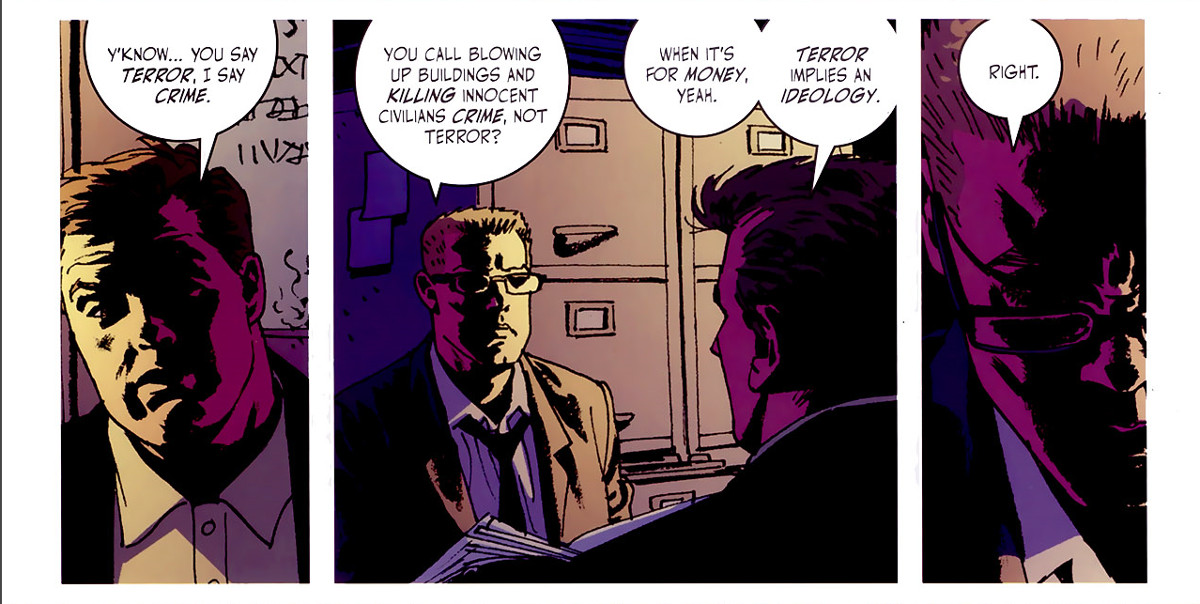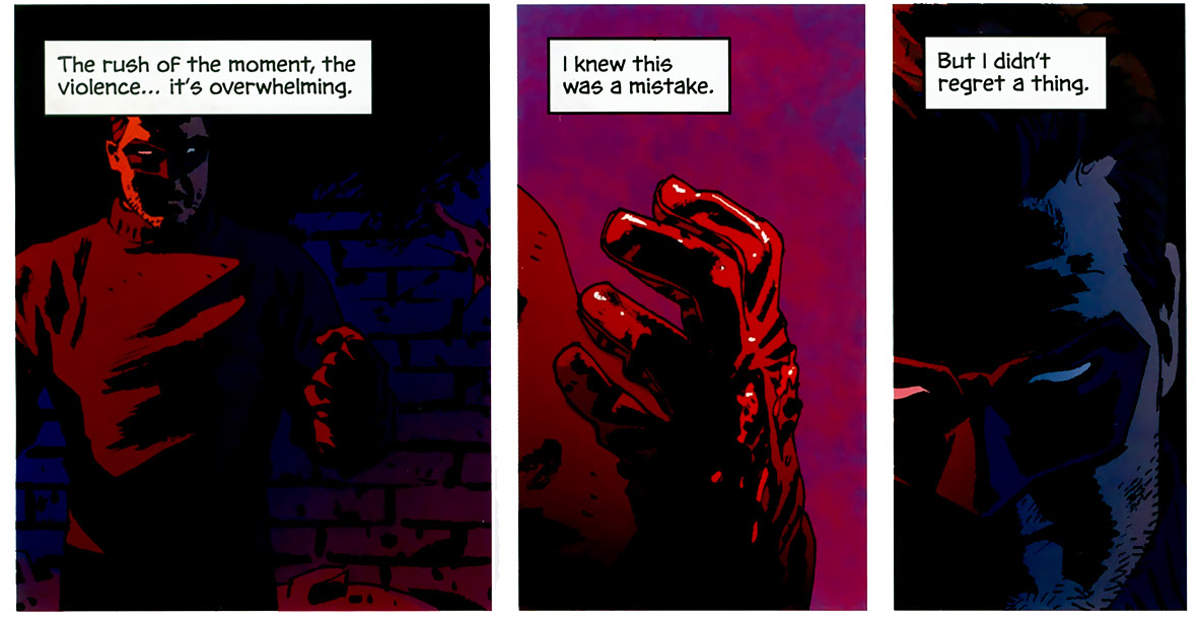Incognito
Antihero In Disguise
As a reader who didn’t grow up with the strict morality of the superhero stories from childhood, it’s interesting to see how the portrayal of superheroes has varied over time period and genre. When I think of the 1940’s superheroes, I tend to think of Batman and Superman in their more boy scout, moral performances rather than the gritty stories that we’ve seen in the last few decades. But if you consider the pulp comics like Doc Savage, The Shadow and The Spider, it’s interesting to note that comics have occupied a moral gray area from pretty early on. Some of the pulp heroes like The Spider remind me much more of The Punisher in their willingness to commit violence than the stereotypical boy scout superhero like Superman is often portrayed. What is not surprising is that it would be the same duo who gave us the Lovecraftian noir story of Fatale who would tackle superheroes, pulp and noir in the present day. Ed Brubaker and Sean Phillips took a break from the noir story Criminal to write a dark superhero story that focused on the villain rather than the hero. The series is called Incognito and has two parts. The first series was written in 2009 and was followed by a second series in 2011 called Incognito: Bad Influences that has more spy, noir overtones. For those unfamiliar with Fatale, Brubaker handles the writing and Phillips handles the illustrations. Val Staples joins them for the coloring in this series and was so good that he was nominated for an Eisner award.
The original Incognito series is the story of Zack Overkill, a former supervillain who has been integrated into the Witness Protection Program after informing on his boss. Zack and his twin brother Xander were raised by a mad scientist who was part of a criminal organization known as The Black Death. The Overkill twins were a force to be reckoned with but when the leader of The Black Death (conveniently also called Black Death) suspected of them of being traitors, he set them up to die. Zack survived while Xander did not and when the good guys found him, Zack was given little choice but to turn to the other side or join his old boss in prison. When the story opens in Incognito, Zack is trying to fit into the dull, 9-5 life of a normal person and feeling miserable. He’s been ordered to take drugs to suppress his powers but growing up with supervillains has left Zack with little understanding of or empathy for normal people. When he finally discovers a way to use his powers without getting caught, Zack gets dragged back into the world of superheroes and villains. Much as he’s relieved to be able to live again, Zack is forced to choose between the superheroes who aren’t sure he can even be rehabilitated and are constantly suspicious of him and the supervillains who want him dead for acting as an informant. As per Brubaker’s usual, there are many shades of gray in this story.
Brubaker is one of those creators that I almost can’t stop talking about so it was almost a given that I’d love this one. But even apart from that, I’ve always loved the antihero. Since I was a kid, I’ve felt more drawn to characters that straddled the line between black and white rather than embracing the “truth, justice and the American way!” stereotype. I’ve never thought of life as black and white so I like seeing that reflected in the characters I read about. Zack Overkill is a fantastic antihero. He’s a man who grew up thinking of normal people as sheep who were there to be used or dismissed as collateral damage. So suddenly being one of them is understandably a struggle for him. At first, he’s just looking for an escape but as he suddenly gets access to his powers again, Zack has the choice of what to do with them. Instead of screwing himself over by turning immediately back to being a supervillain, Zack chooses to use his powers to fight small, petty crimes that are more likely to go unnoticed by the government agents who are watching him. Despite the somewhat good nature of his actions, it’s still clear that Zack doesn’t give a shit about normal people and is actively annoyed by them. Throughout the series, it was interesting to see the slow development of empathy in Zack. Thankfully he doesn’t fully transition to reformed villain in the original series but the growth he makes as a character was believable and interesting in its moral gray scale.
In Incognito: Bad Influences, Zack is working for the superheroes because his life has left him little choice. Where the original series is pulp noir, Bad Influences has more of a spy noir feel to it. Zack is sent undercover into one of the supervillain organizations that rivaled The Black Death organization in which he grew up. Zack must find a government agent who has been undercover for years and has recently stopped checking in. Putting Zack back in old territory forces him to recognize his old lifestyle and whether or not his priorities and his views of people have changed since he left the supervillain world. Bad Influences pushes Zack even further along on his development of empathy for the people around him. He runs into a number of people who he starts to see differently now that his involvement with the side of “good” has forced him to re-examine his worldview. Brubaker definitely sets you up to expect a reformed supervillain, happy ending and then turns that on its head with an ending that it feels like the entire series had been building to. While I should know better than to expect a happy ending from a Brubaker story, it still managed to surprise and impress me.
One last note because I cannot wrap up without talking about the artwork: Val Staples completely deserved that Eisner nomination. Sean Phillips’ artwork is as gorgeous as ever. He nails the noir feel of the story by complementing it with dark nighttime scenes of Zack prowling the streets or suffering under the harsh daylight of the cubicle world. But Val Staples creates such atmosphere with his coloring that I was completely blown away. Different color palettes are used to differentiate between flashbacks and the colorless life that Zack is now living. Sometimes with other graphic novels, you get the sense that the artwork is just part of the story, it’s there to illustrate the words and that’s it. But Staples and Phillips show the reader how Zack is feeling through color and art, how alive he feels prowling the streets and using his powers, and how useless and dead he feels in the real world. Graphic novels are wonderful because they can both tell and show and Incognito is a perfect example of that.
Incognito and its follow-up, Bad Influences, are an unusual mix of superhero, pulp and noir that ends up complementing each spectacularly. As a former supervillain in hiding, Zack Overkill is both compelling as a character and disturbing for his view of the normal people around him. The development of empathy in Zack’s mind over the course of the series was an interesting look at how we view morality, whether people can change and a challenge to the expectations we have for our superheroes. If you’re a fan of dark, morally conflicted stories or even just superhero or pulp stories in general, you need to read Incognito.





